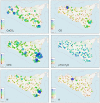XRF analysis searching for fingerprint elemental profile in south-eastern Sicily tomatoes
- PMID: 37612357
- PMCID: PMC10447457
- DOI: 10.1038/s41598-023-40124-6
XRF analysis searching for fingerprint elemental profile in south-eastern Sicily tomatoes
Abstract
The implementation of analytical techniques able to certify food quality and origin in a fast and non-destructive way is becoming a widespread need in the agri-food sector. Among the physical non-destructive techniques, X-ray fluorescence (XRF) spectrometry is often used to analyze the elemental composition of biological samples. In this study, X-ray fluorescence (XRF) elemental profiles were measured on tomato samples belonging to different geographical areas in Sicily (Italy). The purpose of this investigation was aiming to establish a protocol for in-situ measurement and analysis able to provide quality assessment and traceability of PGI agri-food products, specifically sustaining health safety and self qualifying bio-chemical signature. In detail, sampling was performed in one of the most tomato productive area of south-eastern Sicily (Pachino district), characterised by a relative higher amount of Organic Carbon and Cation Exchange Capacity, and compared with samples from other growing areas of Sicily, falling in Ragusa province and Mt. Etna region. Experimental data were analyzed in the framework of multivariate analysis by using principal component analysis and further validated by discriminant analysis. The results show the presence of specific elemental signatures associated to several characterizing elements. This methodology establishes the possibility to disentangle a clear fingerprint pattern associated to the geographical origin of an agri-food product.
© 2023. Springer Nature Limited.
Conflict of interest statement
The authors declare no competing interests.
Figures







References
-
- Natesh H, Abbey L, Asiedu SK. An overview of nutritional and antinutritional factors in green leafy vegetables. Hortic. Int. J. 2017;1(2):00011. doi: 10.15406/hij.2017.01.00011. - DOI
-
- Gallardo H, et al. Possibilities of low-power X-ray fluorescence spectrometry methods for rapid multielemental analysis and imaging of vegetal foodstuffs. J. Food Compos. Anal. 2016;50:1–9. doi: 10.1016/j.jfca.2016.04.007. - DOI
Publication types
MeSH terms
LinkOut - more resources
Full Text Sources

